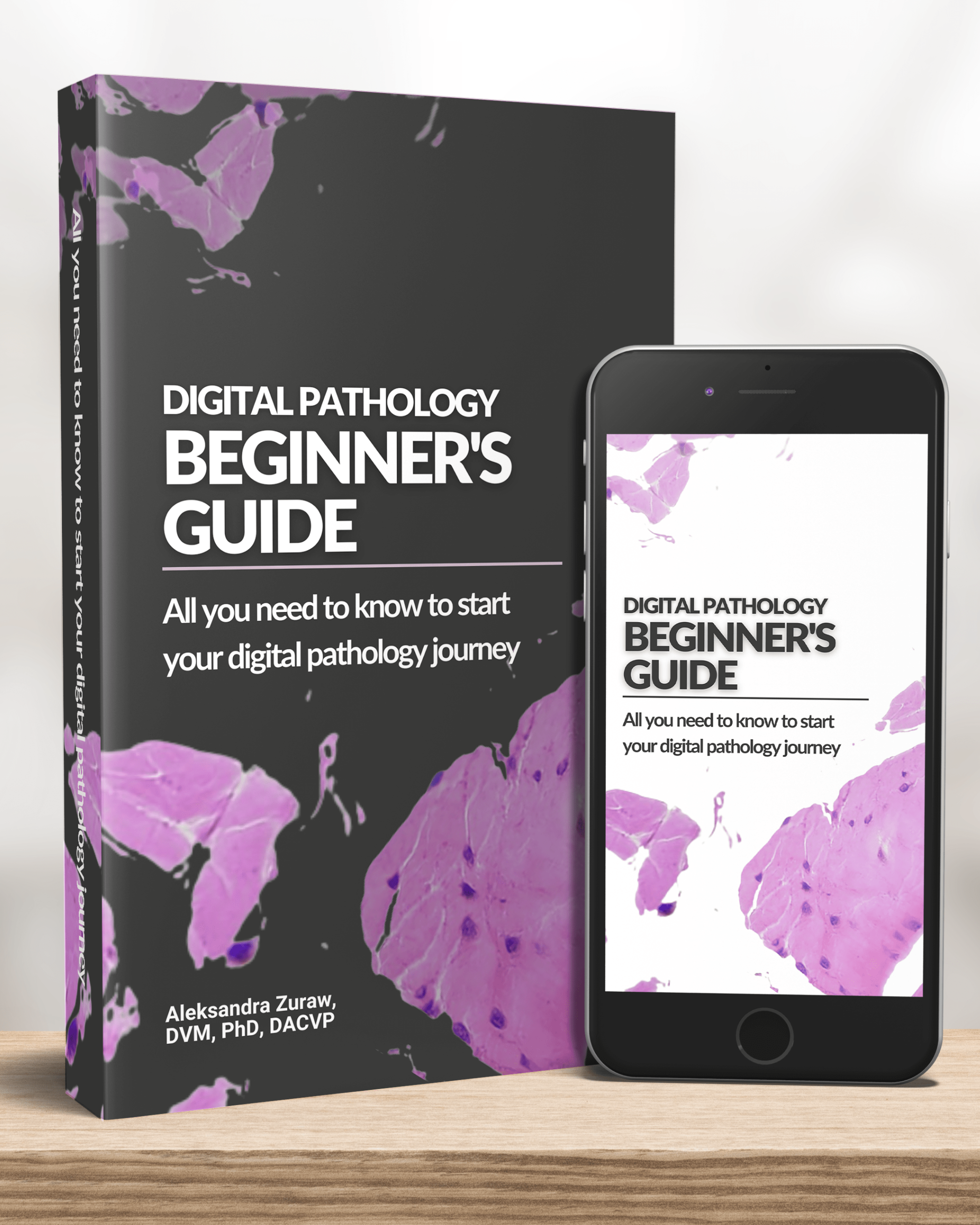Giovanni: That might might tilt the balance because now in order for this practice is to attract this new workforce, they definitely will have to be digital and to be offering this kind of Digital AI Future so I think that kind of we’ve been doing the opposite right trying to target…
Aleks: Convert the old guys who already love their microscopes.
Giovanni: We call ourselves seasoned pathologist.
Aleks: Sorry, I would [00:16:00] call myself maybe mid-career. Mid-career, seasoned, and new generation. These are our categories for today.
Giovanni: I’m just making fun.
Aleks: I’m making this up.
Giovanni: We, the old pathologists, need to understand that. The future belongs to the new generation, so we kind of have to prepare the road for them.
And we haven’t been doing a good job, right, as a specialty. So now they are coming into the workforce and they are creating those, uh, expectations or they are kind of awakening to the new generation. reality that their expectations are not fulfilled by the current workplaces. So I think that would be a good, good way to do it.
Like after I heard this pathologist. Yesterday I went and talked to her and I think what we came up with, you know, plans.
Aleks: Let’s talk about your plan for, uh, for [00:17:00] Path Visions. He just, can you reveal that? If not, that’s okay. We can just cut it.
Giovanni: No, I think, I think…
Aleks: Because at Path Visions, every, all of us are going to be there.
Nick is going to be there, Giovanni and me, and we need to do something like a similar follow up on this one.
Giovanni: Absolutely.
Aleks: Yeah, what did you ask her to do?
Giovanni: We will be, uh, the, the host that the, the podcast that they usually host. It would be…
Aleks: Beyond the Scope by…
Giovannie: Beyond the Scope.
Aleks: DPA-Digital Pathology Association.
Giovanni: Exactly the, the Digital Pathology Association podcast. Beyond the scope, we will be there. Pathology visions, the DPA-sponsored meeting. So we’ll be there in a little bit, like a different format will be doing small on-the-spot interviews. We have our set with, uh, um,
Aleks: Let’s call her Dr. Kawam. Do you want to join us on our impromptu podcast?
Cause we’re talking [00:18:00] about you all the time. Probably your ears are burning.
Nick: Ill come out, bye!
Aleks: Nick, thank you so much for joining. We are having our new guests. So let’s start with the first question. Who are you and why do you like this meeting?
Alae: Uh, my name is Alae, and I like this meeting because it’s a very safe space to share how you feel about digital pathology.
Aleks: She was the pathologist who commented yesterday that new generation is different than their previous generations. And I think it’s, I think people who, let’s say, mid career and seasoned pathologists, often dismiss this as like, like, old pathologist. Um, I think like the feeling is there is a feeling of dismissal of this kind of, um, I don’t know, feelings, perception.
But this is the new reality. These are the people that are going to be the next. diagnosticians of the world. And after COVID, it’s different. So [00:19:00] Dr. Kawam, Alae, tell us, tell us like elaborate on your comment.
Alae: I think that came from a place of personal experience, but I tend to like reflect a lot. And one thing that I realized was like, we do have to work with leadership, right?
You can’t accomplish anything without leadership. And it is on us to say something, but what’s on them is to be receptive to the things that we have. And I won’t. You know, leadership and, you know, the generation that’s basically retiring right now to look at us as an investment. Like, we will basically take on whatever projects that they’re working on.
We are the future. We’re, you know, going to carry on their vision. Now, being clear about the vision, whatever, I mean, the new technology is emerging, right? We have to be the ones to be the segue into making things more efficient, making things more sustainable. Um, I’m a huge advocate for wellness, right? So digital pathology for me, like when I heard it, you know, first learned about digital pathology and remote sign out, oh wow, I can sign up from everywhere.
That’s the way it reverberated with me. Now that’s not necessarily the case. I had a mentor who was like, no, digital sign out for me [00:20:00] means I can send my cases out faster and get, you know, like shorter turnaround time. I was like, no, why would you do that? I mean, work-life balance is one aspect of it. And the reality is, you can’t, you dissociate, you know, the benefits of this technology just for you know, the patient, yes, patient care is paramount.
I am not denying that. That is extremely important. You know, when a patient gets out of the hospital faster, when they get an answer, that closure for the patient is extremely important. However, I will say there are other benefits. Um, when you do think of, like, a large company, um, retention has become an issue over time.
Um, partially because, you know, people are leaving, they’re not happy, whatever, and they want to talk about burnout. It’s a huge conversation. However, when you do introduce this technology and make it part of the standard of, um, The practice. I think I’ve mentioned before. It’s like it’s nice to see digital pathology evolving, but I want to make it the not gluten free option, like make it the standard, not the secondary option.
I think that’s the vision. I think that a lot of people who agree with that. It’s just that how do we get traction for it in [00:21:00] places that are less likely to accept this technology, whether it’s fear, whether it’s fear of wasting money. I mean, that’s a very major concern. Um, but I’m hopeful. Um, I do want to say out to leadership.
Listen to us. We are an investment where we want to learn. We want to work with you. Um, we do see the potential. Um, so yeah, work with us. And we’re here to, you know, we’re here to make the dreams come true.
Giovanni: This is she great. So this is she’s been…
Aleks: The new generation guys.
Giovanni: So I was, I was previously, before she just happened to walk by,
Aleks: I think we like manifested her presence into the show today.
Giovanni: She has graciously accepted to join the DPA podcast for our production and uh, at Pathology Visions. And yesterday I had an idea when, after she talked about that, that we probably would be good to have her co-host with me the interviews. [00:22:00] So when we. I was telling you it’s going to be a different format.
We’re going to, instead of doing long interviews, we’re going to be doing mini-interviews. Some will be pre-arranged with people, but mostly, I think we will just speak out from people walking by. We will be set on the Pathology Visions booth. And the idea now is that we will co-host. And so you will have questions from the new generation and from the old generation.
So we both will kind of interview or, or, or guest from two different angles. Is she that. How our views reflect on, on, on reality when we actually do those questions. I’m very excited about this at the DP at the DPA meeting pathology visions. This will be your host.
Alae: I’m actually super excited for it. I think when we were on the call [00:23:00] talking about it, I was just like, Oh my God, I’m so excited.
I had a moment. Um, but I will say. Don’t be afraid to share how you’re thinking, um, when you have an idea and you feel like, you know, you don’t know who’s listening. And sometimes the people who are in these spaces actually want to hear things. They actually want the feedback. And I’ll say like our generation, we’re very like fearful and anxiety-ridden.
I get that. Been there, done that. But get out of your head and don’t be afraid to share how you feel like that has to come from a confidence within yourself to say like, okay, like I actually believe in this. Um, I see a future in this. I’m going to say something. I am taking a risk, and I’m fully aware I’m taking a risk.
However, if it’s in the right place, they will be receptive to what you’re saying. And I think that, you know, people do want to hear support. You know, we’re supporting this movement. Um, you might not feel it locally where you work, but at the same time, you, you, you will get support in certain spaces, and I will say like, find those spaces where you find the support, make your, you know, connections, network with people, and, you [00:24:00] know, obviously friendship is something super important as well, um, the professional connections are another thing, but, It’s, it’s, it’s these places where you find support and that support can come in the form of ideas.
Hey, did you try this? Did you try getting involved? It’s actually like an unwritten, I don’t know how to explain it. Like there’s no formula. Everything in life, you know, we think that those are from, there’s no formula. You just kind of go with the flow and see how things come to you. And hopefully, um, you will, you know, achieve great, great things.
Aleks: I just want to give a context how this all happened. So yesterday I was a host of a panel and Alae asked a question like, “How do I do it when I don’t have authority to make it happen?” And my answer was like, talk about it, learn it. And the next thing that happened, she speaks up at the fire, uh, fireside chat.
And the next thing that happens is Giovanni asks her to be the co-host of the podcast at PathVision, the digital pathology conference, uh, for the Digital Pathology Association. So like you, [00:25:00] like did what you wanted to do within. Like two day span by just coming to this conference and, um, We already and you did it already ahead of time because we connected on LinkedIn We had the call and you were like I already knew you so when I when we met here We were like LinkedIn friends already
Giovanni: I think I if I was the owner or a pathologist principal in a group and I see her I will hire her right there on the spot, or at least make an offer and try to grab her from wherever she is, because this is what it will drive, and it will kind of, to me, what I think, is that it will bridge the gap between generations, having the new pathologists lead the way of what they want, so that the, all the generations, decision pathologists who are controlling the market right now understand that we need to create and pave the road for them to succeed and flourish, that it’s not only about us.[00:26:00]
That we shouldn’t just be thinking, oh, I’m going to retire in five years, ten years, so I don’t want to hit it. I think we need to be a little bit more responsible, that it’s not about us, it’s about the patients and how the new generations are going to cater to them. And so it was, it was really, it was, it was an eye opener for me.
Alae: I, you know, I want to comment, I want to comment on that and, and it’s, again, it goes back to what I was saying. It’s an investment. We are an investment. You know, these businesses need to keep rolling and you need to make sure that the next generation is prepared, at least with the tools. Um, one thing that I want to share with, I guess, people who are in, you know, a similar vote as me is know how to communicate things appropriately.
Work on your communication skills. Know the jargon, know the language. If you need to sit down on business-type things, just so you can get a sense of how people think, on the other side, the decision-makers, that’s an important skill to have. Um, you don’t need a higher degree for it, but educating yourself within [00:27:00] that space is a very powerful, powerful skill.
And just knowing how to communicate in general, knowing how to link with people, or don’t be afraid to reach out. That’s how, you know, I reached out, I linked in, and that’s how, that’s how we met. The World Wide Web, right? Don’t be afraid to use this web. Don’t be afraid to use resources that are around you.
We really have a lot of power that we just haven’t, um, been conscious of. Um, but we’re here, and we’re, you know, we’re making things happen, so. Awesome. Thank you so much. I appreciate it.












